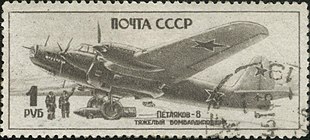Petlyakov Pe-8
Development of the Pe-8 began in July 1934, when the Soviet Air Forces (VVS) issued requirements for an aircraft to replace the obsolete and cumbersome Tupolev TB-3 heavy bomber.In the prototype, space for a fifth engine, an auxiliary Klimov M-100, was reserved inside the fuselage, in a fairing above the wing spars and behind the pilots.It was intended to drive a supercharger that supplied pressurized air to the Mikulin AM-34FRN engines, with the installation designated ATsN-2 (Russian: Agregat tsentral'novo nadduva—Central Supercharging Unit), an idea pioneered in 1918 by the Zeppelin-Staaken firm in the German Empire, and refined further for the Third Reich Luftwaffe's Do 217P and Hs 130E experimental bomber designs.[3][4][5] The maiden flight of the unarmed prototype, piloted by M. M. Gromov and without the ATsN installation, occurred at Khodynka Aerodrome on 27 December 1936.[8] The arrests of both Tupolev and Petlyakov in October 1937, during the Great Purge, disrupted the program and the second prototype did not make its first flight until 26 July 1938.[9] Authorization for production was slow for several reasons, including the Great Purge, but also due to the scarcity of resources, and a shortage of workers.The unavailability of the Klimov M-100 engine of the ATsN-2 installation required a design change, although this modification allowed a commander and radio operator to be carried in its place.[15] When Operation Barbarossa began on 22 June 1941, only the 2nd Squadron of the 14th Heavy Bomber Regiment (Tyazholy Bombardirovochnyy Avia Polk—TBAP), based at Boryspil[16] was equipped with Pe-8s, but was not ready for combat.Stalin ordered that the squadron be reformed into a regiment, and that it strike targets deep inside German territory.[19] On the evening of 10 August, eight M-40-engined Pe-8s of the 432nd TBAP, accompanied by Yermolaev Yer-2s of the 420th Long-Range Bomber Aviation Regiment (DBAP), attempted to bomb Berlin from Pushkino Airfield near Leningrad.The aircraft of the commander of the 81st Long-Range Bomber Division, Combrig Mikhail Vodopianov, to which both regiments belonged, was attacked mistakenly by Polikarpov I-16s from Soviet Naval Aviation over the Baltic Sea and lost an engine; later, before he could reach Berlin, German flak punctured a fuel tank.[17] It spent the rest of the year conducting night raids on Berlin, Königsberg, Danzig and as well as German-occupied cities in the Soviet Union.[22] This was a test run for a flight carrying Soviet Foreign Minister Molotov and his delegation from Moscow to London and then to Washington, D.C., and back, for negotiations to open a second front against Nazi Germany (19 May – 13 June 1942).[17] Under the command of the 45th Long-Range Bomber Aviation Division (Russian: Dal'nebombardirovochnaya Aviatsionnaya Diviziya—DBAD), they did not participate in the Stalingrad air attacks.In addition, the regiment dropped the first FAB-5000 bomb on Königsberg in April 1943, continuing the pin-prick attacks against targets deep in the German rear.The long-range aviation units continued to attack targets in the German rear areas at night, supporting the Soviet ground offensive in the Orel Bulge, called Operation Kutuzov, that began on 12 July.The Germans had transferred the nightfighters of the Fourth Group of the 5th Night Fighter Wing (IV./Nachtjagdgeschwader 5), flying a mix of Junkers Ju 88 and Dornier Do 217 aircraft, to counter the Soviet raids near the Orel area.Aviation historian Yefim Gordon maintains that the Pe-8 flew its last mission on the night of 1–2 August 1944,[29] but the Statistical Digest of the VVS contradicts this claim, showing 31 Pe-8s assigned to 45th DBAD on 1 January 1945 and 32 on hand on 10 May 1945.Their military equipment removed, they had additional fuel tanks installed, were painted orange, and had their engines upgraded to either ASh-82FNs or Shvetsov ASh-73s.
Heavy bomberSoviet UnionPetlyakovSoviet Air ForcesRussianSovietWorld War IIbomb BerlinVyacheslav MolotovUnited StatesVladimir Petlyakovhigh-value targetsLuftwaffeTupolev TB-3TupolevAndrei TupolevcantilevermonoplaneTupolev SBduraluminaileronsmonocoqueKlimov M-100superchargerMikulin AM-34FRNGerman EmpirenacelleFAB-500M. M. GromovKhodynka AerodromeFAB-5000 bombGreat PurgeBerezin UBTbarbettearc of fireMikulin AM-35Charomskiy ACh-30Charomskiy M-40aircraft Diesel enginesPetlyakov Pe-2Shvetsov ASh-82filletOperation BarbarossaBoryspilStalinYermolaev Yer-2sBerlinLeningradFinlandEstoniaCombrigMikhail VodopianovPolikarpov I-16sSoviet Naval AviationBaltic SeaKönigsbergDanzigVolga RiverKalininMolotovLondonWashington, D.C.sortiesBryanskPoltavaStalingradOperation UranusStalingrad air attacksKratovoBattle of KurskOperation KutuzovnightfightersNachtjagdgeschwader 5Junkers Ju 88HauptmannHeinrich Prinz zu Sayn-WittgensteinHelsinkiTallinnLend-LeaseB-25 MitchellsV-1 flying bombBisnovat 5AeroflotASh-82FNsShvetsov ASh-73sNorth Poledrift ice stationsAirfoilMikulin AM-35APower/massShVAK cannonsUBT machine gunsShKAS machine gunsFAB 5000Avro LancasterBoeing B-17 Flying FortressBoeing XB-15Heinkel He 177Nakajima G5NNakajima G8NPiaggio P.108Short StirlingList of aircraft of World War IIList of bomber aircraftList of military aircraft of the Soviet Union and the CISGunston, BillAir InternationalTu-104Tu-114Tu-116Tu-124Tu-134Tu-144Tu-154Tu-164Tu-204Tu-214Tu-334Tu-354Tu-20/Tu-95Tu-22M/Tu-26Tu-28/Tu-128Tu-126Tu-142Tu-160Tu-121C